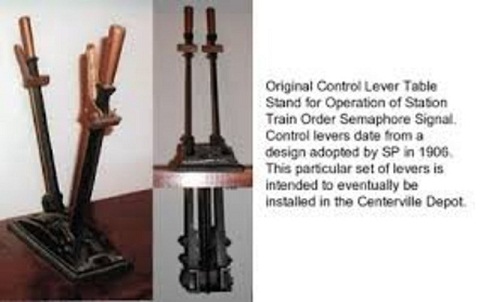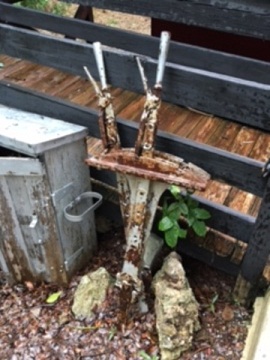
PA3CLQ's Leuke Linken Nr. 415
Orion 565 UCW vs LCW? (CW vs CW-R)
One of our ops passed along this problem with N1MM+ and my Orion 565.
The Orion lets you choose UCW (upper cw) or LCW (lower cw) as your mode.
While
I tend to leave it in one position or the other for all bands, many choose to
the follow the phone band conventions (160-40 = LCW; 20-10 = UCW).
"I noticed the Orion was in UCW instead of LCW.
I
would change the mode manually but N1MM+ would switch it back to UCW every time
I pressed a button."
"I have the same problem with MM+ on my Mark V and the developers haven't
addressed the need for radios to shift from Lower to Upper sideband when moving
up the bands and vice versa when moving down the bands."
Is there a solution to this or should i just leave it one way or the other?
73, Eric Rosenberg W3DQ
REM :
What
is the advantage of changing from ucw to lcw when changing bands?
Tom - N1MM
REM :
Eric,
Use the Config, Other tab option for reverse CW.
John, K3CT
REM :
I'm the other op so let me answer both questions.
First, the reason to change from lcw to ucw is to follow the conventions.
Not so important during S&P but when running on a crowded band with the filters screwed down to 200 Hz the guy calling on the other sideband is, at best, harder to copy.
Second, yes, John, I reconfig for reverse CW but that needs to be done whenever you go from 20 to 40 or 40 to 20 *if you follow the conventions* and that's not a really convenient thing to do in the heat of battle.
All that said, I know a lot of contesters simply stay in ucw regardless of band but I'd prefer my software to follow the conventions.
regards, Peter W2CDO
REM :
"Follow the conventions"? I don't follow.
The convention about sidebands above and below 10 MHz applies to SSB.
AFAIK it has nothing to do with CW (or digital modes).
If you are tuned in exactly to a CW signal, it will sound the same in both sidebands.
The difference is only heard in signals that are not on exactly the same frequency as yours.
If you are CQing, if an off-frequency signal is higher in frequency than yours is, it will sound higher in pitch than your sidetone in UCW, whereas it will sound lower in pitch than your sidetone in LCW.
On the other hand, if it is lower in frequency than yours is, it will be the opposite (lower in pitch in UCW and higher in pitch in LCW).
Assuming errors are equally likely to be in both directions, it doesn't matter which sideband you pick, half the off-frequency signals will sound higher than your sidetone and half will sound lower.
The
only difference is in which signals will be in which half.
Seems to me that the place where the difference is most likely to
be noticed is when you are S&Ping and tuning across the band.
In UCW, if you tune upwards, signals first appear at high pitch and drop in pitch as you tune.
If you tune downwards, signals first appear at low pitch and climb in pitch as you tune.
In LCW, it's the opposite.
If you always tune in the same direction and the direction of the change in pitch matters to you, you might prefer one sideband over the other, but if so, your preference should be the same on all bands.
I can't think of a good reason why you would want it to be different on different bands, unless you use the direction of pitch change as a mnemonic to remind you which band you are S&Ping on.
I can more easily see wanting to switch sidebands whenever you change from tuning upwards to tuning downwards, as Eric suggested, but that is independent of which band you are on.
73, Rich VE3KI
REM :
Yes Rich, that's how it works.
The conventions about sidebands apply to CW as well as SSB.
That's why my transceiver switches from one to the other when I change bands manually.
That distinction may have changed but I didn't get the memo.
73, Peter W2CDO
REM :
Peter,
Are you sure you haven't just configured the settings on your radio that way and the radio remembers them that way for you?
Also, as far as I know, there is no such thing as the "guy calling on the other sideband".
Changing between CW and CW-Reverse or ucw vs lcw only applies to receiving.
Gerald, VE1DT
REM :
Yes Rich, that's how it works.
The conventions about sidebands apply to CW as well as SSB.
Where is that written?
That's why my transceiver switches from one to the other when I change bands manually.
The whim of the developer.
What transceiver?
Are you saying that in your rig, for CW the receiver listens in USB for the upper bands and LSB for the lower bands?
(It will not affect your transmitted CW signal at all.)
73, John K8AJS
REM :
Gerald, that's certainly possible.
It's been a long time.
Yes John, that's the way my Mark V has been working for ~15 years (see Gerald's suggestion).
Got the memo now, thanks.
Peter.
Hi All,
On my way somewhere else I tripped across the following article from Cornell University where one of the original Morse Registers as crafted by Alfred Vail is kept.
The project was to produce a copy using 3D printing technologies and this is the link to that article: http://creativemachines.cornell.edu/sites/default/files/SFF09_Alonso.pdf
73, Chris Hausler
REM :
Chris:
A chap that works with my daughter, Dr. Paul Tinari, has written a book on 3D printing.
Just google his name and the info will come up
Lavina Shaw
REM :
I have a 3-D printer capable of a large variety of materials and some of the things I've been wanting to print with it have been parts for sounders and keys.
I've been tied up doing other things with it so I haven't had a chance to try any of those parts.
It can print your standard plastics along with materials loaded with steel, brass, copper, etc. and a conductive polymer.
I was going to try printing an entire sounder and wind the coils as I don't think the conductive polymer is conductive enough to produce a good magnetic field.
After reading the article, I may give it a shot, but first I'll have to get a dual extruder head and that's not in the budget right now.
But,
there's lots of other parts to design and print before I get to the coils
anyway.
Some of the first parts I want to try are coil bobbins and straight key knobs
as those parts seem to be missing on a lot of otherwise good stuff.
I
can even do the coil covers in a plastic as opposed to brass, but they would
look OK anyway.
There's some neat stuff that can be done with them, but the more capable and
flexible machines are definitely not "plug and play"!
The
things are fascinating to watch as they print out a part, though.
73, Chip Morgan
REM
:
Lavina,
Thanks for that tidbit.
I haven't gotten through all of his materials, but speaking as an engineer he really has some good ideas.
Many of which are happening already regarding 3-D printing.
So far, I've seen him reference objects that we would use as productive items, but there is a large amount of art being produced with the 3-D printers.
Just
recently, researchers have been printing human organs.
Maybe we will be able to produce a complete telegraph office at some point -
might open up a whole new pool of telegraphy enthusiasts when the available
workable antique equipment becomes prohibitively expensive.
Download MorseKOB and the CAD files and you can have a working telegraph office at home.
It's
the kind of stuff he's predicting.
73, Chip SlowSpeedWireGroup
They Did It Again
Over the weekend I watched a PBS documentary, "Humanity From Space," which I had redcorded a week or ten days ago.
The thrust of the program was to show how, looking from space, we can see how the entire world is interconnected, and then to trace all of the various types of interconnectity from their origins.
It took until the second hour for them to get to the telegraph, and when they did, they showed a radio type key which they called "the electric telegraph", sending tones!
Shortly after that, they mentioned the trans-Atlantic cable, and
showed a similar key, again sending tones.
I think the program may have been produced in England, as most of the
commentators spoke with an English accent, and the two telegraph keys appeared
to be of the type used by the British military in WW II. If it is a British
production, it just shows that they know no more than U.S. producers about
telegraphy.
Will the never learn?
If anyone is interested in watching the program, it is said to be available
online at PBS.org.
73 - Warren
REM :
Hi Warren,
Yes, I've seen this program.
It has been broadcast several times in the last several months.
Although overall a very good and interesting program there are a number of details in various areas that in my opinion they get wrong and this one, to those of us of a telegraphic persuasion, is most egregious.
Frankly, I also think that in their analysis of overall impact,
the telegraph was given short shift relative to some of the other developments
they addressed.
73, Chris Hausler SlowSpeedWireGroup
REM :
http://www.pbs.org/program/humanity-from-space/
The whole film at:
https://www.youtube.com/watch?v=8UCmCs7hc1g
73, have fun Jan P. pa3clq
Info needed on these levers
All,
I recently found these two levers displayed at a historic railroad exhibit while on vacation in FL.
Old photos of the nearby area show a depot with a signal mast.
There appear to be two control rods running up the mast.
Can anyone confirm whether these levers may have been used to operate the semaphores at the top and whether it might have been a TO or manual block signal?
Note the three locking grooves on each lever frame. Your opinions are welcome.
73, Ken Jamin SlooSpeedWireGroup


REM :
Can anyone tell me how to diagram this sentence, lifted from the caption to the photograph?
"This
particular set of levers is intended to be eventually installed in the
Centerville Depot."
Kinda
convoluted grammar, ain't it...?
-- 73 SW & abram burnett
Hello
friends,
Two mini Tasmanian Devils now live in captivity in the SSN Zoo and can be seen
in Steve's - VK7CW SSN webpage:
http://www.sideswipernet.org/keys/vk7cw-keys.php#mini_steel_ruler
http://www.sideswipernet.org/keys/vk7cw-keys.php#project_box
Well done Steve, very neat work.
Have
fun on the air.
Have a nice day fellows, BCNU.
Hello friends,
I've posted two YouTube videos about making a new sideswiper: the Flex Cootie.
https://www.youtube.com/watch?v=I2M18kJL7es
https://www.youtube.com/watch?v=TSwL8KwnzUM
Please take a look..
73 Durk, PA3BYW
Hello
friends,
Franco
- PY1EPU sent me this link to a very informative and well made video on the
history of the telegraph key, very nice summary:
https://www.youtube.com/watch?v=yw9z82COjU8
Thanks very much Franco, have fun on the air.
Durk's
Flex Cootie or the sideswiper permanently reinvented at PA3BYW.
Admire the cleverness of the mechanism and the virtuosity of the operator.
Detailed narrative, picture and videos available:
http://www.sideswipernet.org/keys/pa3byw-keys.php#flex_cootie
Bravo
maestro, oant sjen!
Have a nice day gents, BCNU.
http://www.sideswipernet.org/
73, Yann, F5LAW.
73, your Editor PA3CLQ
-30-
My simple website about Gigantic DF-Antennas
Part 1 "DF-Antenna Wullenweber Array"
Part 2 "DF-Antenna USSR Variants"
Part 3 "DF-Antenna USA Variant"
Next Part 4 "USSR OTHRA DUGA 1,2 & 3" at: